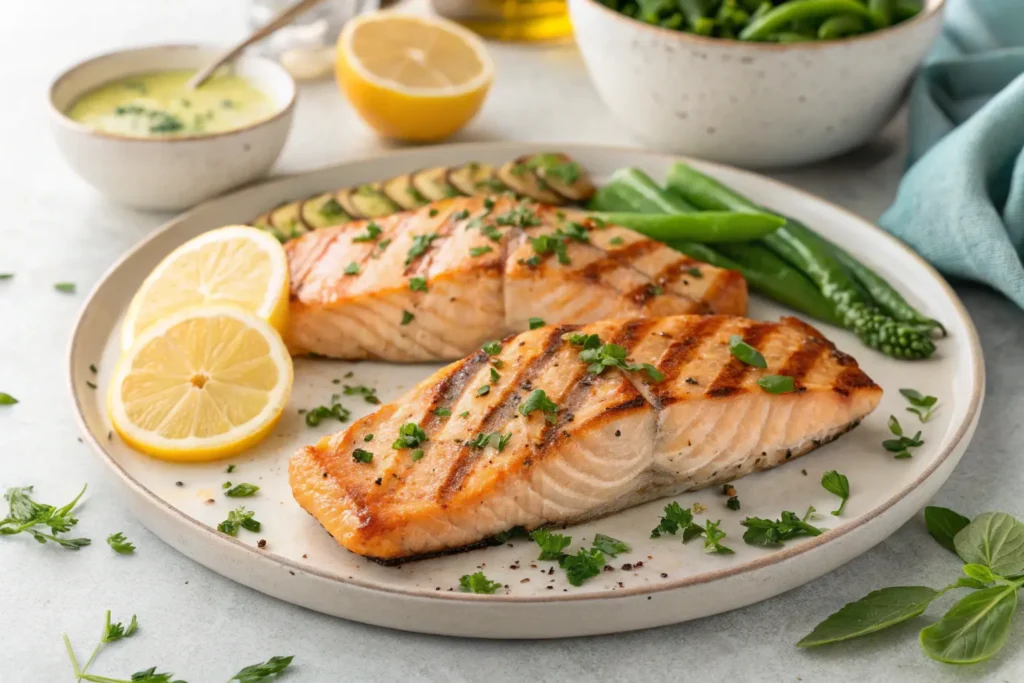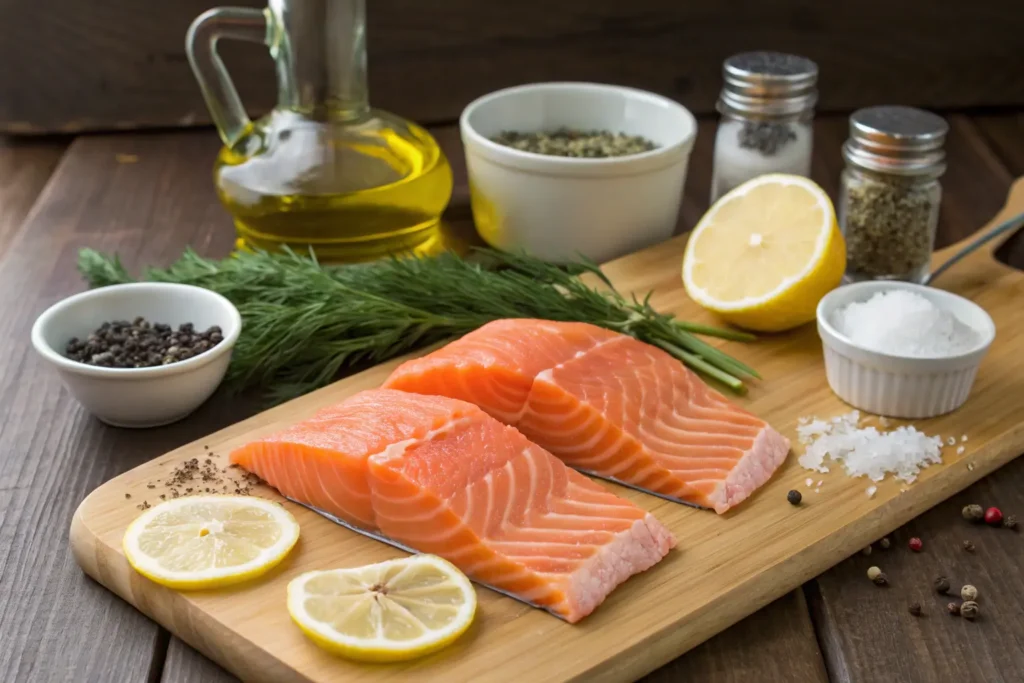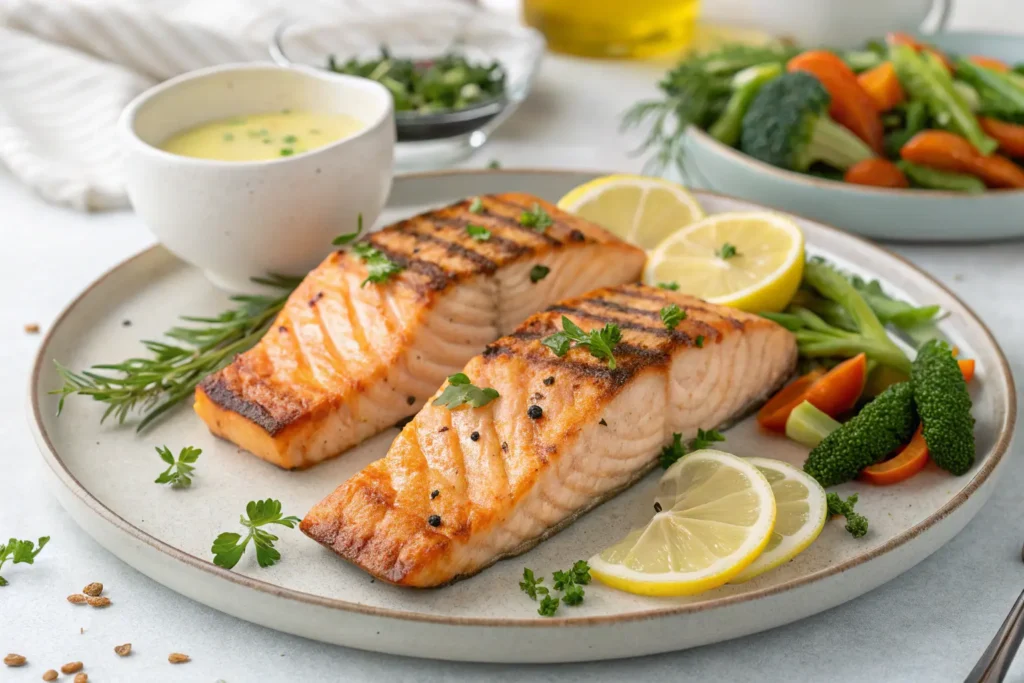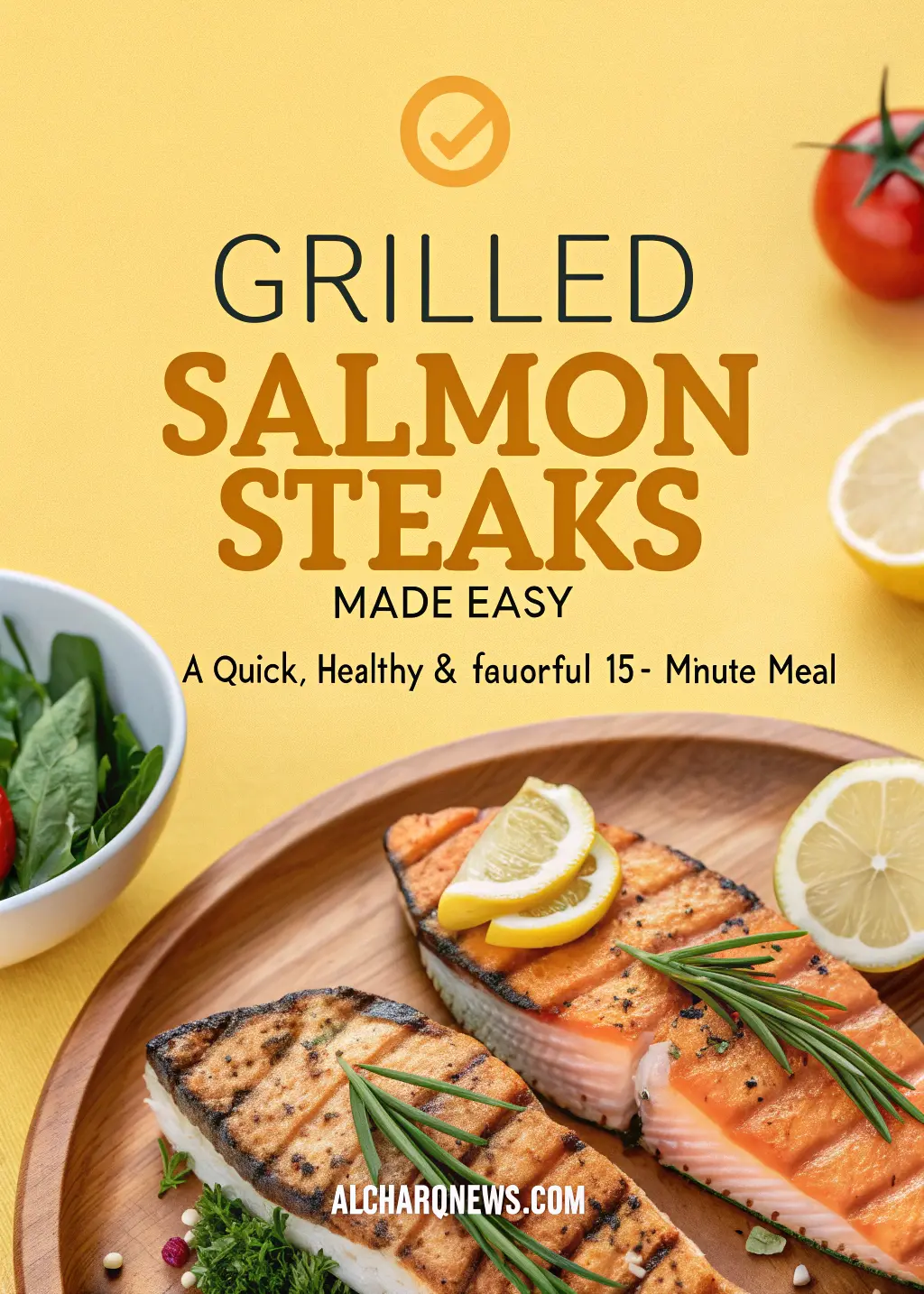Ever stood before your grill, premium salmon steaks in hand, wondering if culinary disappointment lurks moments away? That familiar knot of uncertainty tightening as you contemplate whether tonight’s dinner will inspire delight or regret?
I once shared your hesitation. Despite numerous attempts and far too many salmon sacrifices, mastering the perfect grilled salmon steak seemed an elusive achievement. Yet persistence revealed what countless home cooks discover too late: grilling magnificent salmon steaks requires surprisingly minimal effort when armed with proper technique.
Through trial and unexpected triumphs, I’ve refined this process into a reliable 15-minute method that transforms ordinary weeknight dinners into extraordinarily flavorful experiences. Put aside concerns about overcooked, flavorless fish—your path to consistently perfect grilled salmon steaks awaits below.
Table of contents

What Makes Salmon Steaks Different From Fillets?
Before firing up your grill, understanding salmon anatomy proves crucial. Salmon steaks differ fundamentally from their fillet counterparts, offering unique advantages particularly suited to grilling.
Salmon steaks represent cross-sectional cuts that include the backbone, producing distinctive horseshoe-shaped portions. Unlike fillets (cut parallel to the backbone, typically boneless or containing minimal pin bones), steaks maintain structural integrity during cooking thanks to their central bone framework.
This anatomical difference creates several grilling advantages. The retained bone structure helps steaks hold together beautifully through flipping while distributing heat consistently throughout the flesh. Additionally, the cut exposes more surface area to flame, developing richer caramelization and flavor complexity.
Nutritional profiles remain impressively similar, with both cuts delivering outstanding omega-3 fatty acids, complete proteins, and essential vitamins. However, steaks often provide slightly higher nutrient density thanks to bone-adjacent meat containing concentrated minerals.
Selecting Perfect Salmon Steaks for Grilling
How to Choose Quality Salmon Steaks
Your culinary success begins well before heat touches fish. Selecting remarkable salmon steaks requires attention to several quality indicators:
When examining fresh versus frozen options, neither inherently outperforms the other. Fresh salmon offers immediate convenience, while properly flash-frozen seafood often preserves peak condition from water to market. The quality of handling matters significantly more than preservation method.
Consider source carefully—wild-caught salmon typically provides firmer texture and richer flavor profiles, while farm-raised alternatives offer consistent availability and milder taste. Either choice yields delicious results when quality sourced.
Visual freshness indicators deserve careful attention. Seek moist, glistening flesh with vibrant coloring ranging from deep orange to rich red (varying by species). Avoid specimens showing browning edges, excessive liquid in packaging, or strong fishy aromas—all suggesting compromised freshness.
For ideal grilling performance, select steaks measuring 1 to 1.5 inches in thickness. Thinner cuts prone to overcooking and thicker portions requiring complicated temperature management both present unnecessary challenges for weeknight cooking.
Environmental consciousness also belongs in your selection process. Look for Marine Stewardship Council certification or similar sustainability indicators ensuring your delicious dinner doesn’t contribute to oceanic resource depletion.
Essential Equipment for Grilling Salmon Steaks
Successfully grilling salmon steaks requires minimal specialized equipment:
Your heat source—whether gas grill, charcoal setup, or indoor grill pan—each performs admirably. Gas offers precise temperature control, charcoal delivers distinctive smoky notes, while grill pans provide apartment-friendly alternatives without sacrificing those coveted grill marks.
Several tools elevate your experience from functional to flawless. A thin-edged fish spatula facilitates gentle flipping while minimizing breakage risk. Quality tongs provide secondary support during challenging turns. An instant-read thermometer eliminates guesswork, ensuring perfect doneness without cutting into your beautiful steaks.
Optional enhancements worth considering include cedar planks (imparting subtle woody essence while protecting delicate flesh), grilling baskets (securing smaller portions), and silicone brush sets (for precise marinade application).
Quick & Easy Salmon Steak Marinade Options
Elevating salmon requires minimal intervention—quality steaks need only complementary flavors rather than flavor masking. Consider these three distinctive marinade approaches, each requiring just 15-30 minutes of contact time before cooking.
Classic Lemon Herb Marinade
Perfect for first-time salmon grillers
| Ingredients | Quantity |
|---|---|
| Fresh lemon juice | 3 tablespoons |
| Olive oil | 2 tablespoons |
| Minced garlic | 2 cloves |
| Fresh dill | 1 tablespoon |
| Salt | 1 teaspoon |
| Black pepper | ½ teaspoon |
This bright, Mediterranean-inspired combination enhances salmon’s natural richness with acidic brightness. Simply whisk components together and brush liberally across both sides of your steaks before allowing brief rest time while preparing your grill.
Asian-Inspired Soy Ginger Marinade
Bold flavors that complement rich salmon
| Ingredients | Quantity |
|---|---|
| Low-sodium soy sauce | 3 tablespoons |
| Rice vinegar | 1 tablespoon |
| Honey | 2 teaspoons |
| Fresh ginger | 1 tablespoon |
| Sesame oil | 1 teaspoon |
| Green onions | 2 tablespoons |
This umami-forward profile introduces complexity without overwhelming salmon’s delicate notes. Combine ingredients thoroughly before applying to steaks. The honey component helps develop exceptional caramelization during grilling—creating irresistible exterior texture contrast.
Mediterranean Herb Marinade
Aromatic summer profile
| Ingredients | Quantity |
|---|---|
| Olive oil | 3 tablespoons |
| Lemon zest | 1 teaspoon |
| Fresh oregano | 1 tablespoon |
| Fresh thyme | 1 tablespoon |
| Minced garlic | 2 cloves |
| Salt & pepper | To taste |
Channeling coastal Mediterranean cooking traditions, this herbaceous blend celebrates salmon’s versatility with earthy aromatic notes. After combining components, massage gently into steaks before the brief marination period.

Step-by-Step Guide to Grilling Perfect Salmon Steaks in 15 Minutes
Preparation Phase (5 Minutes)
Successful grilling begins before flames appear. Follow these preparation steps methodically:
- Remove salmon steaks from refrigeration approximately 15 minutes before cooking—allowing their temperature to moderate slightly improves cooking evenness dramatically.
- Pat surfaces thoroughly dry using paper towels—excess moisture creates steaming rather than proper caramelization.
- Apply your chosen marinade or seasoning blend, ensuring even coverage across all exposed flesh.
- Preheat your grill meticulously to medium-high heat (400-450°F)—this specific temperature range creates proper searing without carbonizing delicate proteins.
- Oil grill grates immediately before cooking using tongs holding oil-soaked paper towels—this crucial step prevents frustrating sticking issues that destroy presentation.
Grilling Process (8-10 Minutes)
The moments of truth arrive when salmon meets heat:
- Position salmon steaks directly on prepared grates, arranging thicker portions toward hotter zones if your grill offers uneven heating.
- Allow undisturbed cooking for 4-5 minutes on the initial side—resisting the temptation to reposition prematurely prevents tearing and sticking.
- Watch for visual transformation indicating flipping readiness: edges becoming visibly opaque with color changing approximately one-third up the side of each steak.
- Execute the critical flip using your fish spatula, sliding gently underneath while supporting the top with tongs if necessary—swift, confident movement prevents structural failures.
- Complete cooking on second side for just 3-4 minutes—the common mistake of equal cooking time typically overcooks this side.
- Verify doneness using your instant-read thermometer inserted into the thickest section, seeking 145°F internal temperature—visual indicators include easy flaking with fork tines and primarily opaque flesh with minimal translucence remaining at center.
Resting and Serving (2 Minutes)
Patience during these final moments differentiates good results from exceptional ones:
- Transfer cooked steaks to serving platter using your fish spatula, moving deliberately to maintain structural integrity.
- Allow brief but essential 2-minute resting period—this thermal pause redistributes internal moisture throughout the flesh.
- Consider final season adjustment—perhaps fresh herb garnish, light citrus squeeze, or finishing salt application—addressing your personal preference.
Quick and Healthy Side Dishes for Grilled Salmon Steaks
5-Minute Side Options
Transform your magnificent salmon steaks into complete meals with these rapid accompaniments:
- Lemon-dressed arugula salad—simply toss peppery leaves with fresh juice, quality olive oil, salt flakes and cracked pepper
- Steam-in-bag vegetables finished with herb butter—convenient yet elegant when arranged thoughtfully
- Microwaved quinoa tossed with chopped fresh herbs—delivering complex carbohydrates and complementary protein
- Diced avocado and halved cherry tomatoes with balsamic drizzle—providing satisfying textural contrast
Make-Ahead Sides That Pair Perfectly
Streamline dinner assembly by preparing these complementary options hours or even days ahead:
- Cucumber ribbons marinated in dill-infused vinegar—refreshing counterpoint to salmon’s richness
- Assorted roasted vegetables prepared during weekend meal preparation—simply reheat while salmon rests
- Herbed couscous salad with toasted pine nuts—offering textural variety alongside satisfying starch
- Sweet potato wedges requiring only quick reheating—their caramelized edges echoing salmon’s grilled character
Common Grilled Salmon Steak Mistakes to Avoid
Even experienced cooks occasionally commit these surprisingly frequent errors:
- Starting with refrigerator-cold salmon—guaranteed formula for overcooked exterior alongside undercooked interior
- Selecting excessive heat settings—salmon’s natural oils require moderate temperatures, not blazing infernos
- Extended marination periods—anything beyond 30 minutes essentially “cooks” delicate proteins through acidic activity
- Premature flipping attempts—patience allows natural release from grates once properly seared
- Overcooking through outdated safety concerns—modern food safety guidelines acknowledge 145°F internal temperature as perfectly safe while maintaining moisture
Health Benefits of Including Grilled Salmon Steaks in Your Weekly Menu
Beyond remarkable flavor, grilled salmon steaks deliver impressive nutritional advantages justifying regular inclusion:
Exceptional omega-3 fatty acid concentration supports cardiovascular health through inflammation reduction and improved cholesterol profiles. A single 6-ounce salmon steak typically delivers over 2000mg combined EPA and DHA—meeting weekly recommended intake in one delicious portion.
Complete protein composition provides all essential amino acids necessary for tissue repair and muscle maintenance. Each steak typically offers approximately 30-35 grams of high-bioavailability protein.
Impressive vitamin content—particularly B complex and vitamin D—supports energy metabolism and immune function. For regions experiencing limited sunlight, salmon’s natural vitamin D content provides particularly valuable supplementation through food sources.
Regular consumption correlates with improved cognitive function, reduced inflammation markers, and enhanced mood regulation through numerous observational studies. While correlation doesn’t prove causation, substantial evidence suggests neurological benefits beyond simple nutrition.
Storing and Repurposing Leftover Grilled Salmon Steaks
Transform leftover salmon steaks into entirely new culinary experiences:
Proper storage fundamentals include prompt refrigeration in airtight containers, consuming within 2-3 days maximum. Avoid freezing cooked salmon when possible—textural degradation occurs noticeably upon thawing.
Consider these creative repurposing approaches:
- Flaked salmon folded into scrambled eggs with fresh herbs for protein-packed breakfast
- Chilled salmon chunks atop mixed greens with cucumber, avocado and light vinaigrette
- Room-temperature salmon flakes incorporated into pasta primavera with lemon cream sauce
- Salmon salad with Greek yogurt, dill and capers as sandwich filling or cucumber boat topping

Conclusion: Mastering the Art of Quick and Delicious Grilled Salmon Steaks
With these straightforward techniques now firmly in your culinary toolkit, grilled salmon steaks need never intimidate again. The once-mysterious process resolves into simple steps delivering consistent excellence with minimal effort investment.
Rather than reserving salmon for restaurant experiences, embrace this 15-minute approach for transforming ordinary weeknights into memorable dining without excessive preparation or cleanup demands. The combination of outstanding flavor, impressive nutritional profile and remarkable simplicity positions grilled salmon steaks perfectly for regular menu rotation.
Tonight represents your perfect opportunity to surprise family or guests with restaurant-quality results requiring remarkably little effort. Simply select quality ingredients, follow these straightforward techniques, and prepare for sincere compliments on your apparently elaborate weeknight creation.
Ready to elevate your grilling expertise? Share your salmon steak experiences or questions in comments below—our community thrives through shared discoveries and collective wisdom!
FAQ About Grilled Salmon Steaks
How do I know when my grilled salmon steaks are done?
Perfectly finished grilled salmon steaks reach precisely 145°F internal temperature when measured with a reliable instant-read thermometer. Visually, watch for easily separated flakes when gently pressed with fork tines. The center maintains slightly translucent appearance while remaining primarily opaque—providing ideal moisture retention.
Can I grill frozen salmon steaks without thawing?
While technically possible to cook frozen grilled salmon steaks, the results compromise both texture and flavor. The extreme temperature differential creates inevitable overcooking along edges while potentially leaving dangerously undercooked centers. For optimal 15-minute results, always completely thaw your steaks—preferably overnight in refrigeration rather than using accelerated methods.
What’s the best type of salmon for grilled salmon steaks?
King (Chinook) salmon delivers exceptional results through higher fat content creating natural moisture insurance against overcooking. Sockeye offers striking visual presentation with intense red coloration alongside robust flavor. However, readily available Atlantic salmon provides excellent everyday options balancing accessibility with consistent performance for your grilled salmon steaks adventures.
How thick should salmon steaks be for grilling?
Select grilled salmon steaks measuring precisely 1 to 1.5 inches in thickness for optimal results. Thinner cuts inevitably overcook before developing proper exterior caramelization, while excessively thick portions require complicated heat management techniques unsuitable for quick weeknight preparation.
Can I make grilled salmon steaks ahead of time for a party?
Grilled salmon steaks deliver peak excellence directly from cooking. While technically possible to prepare ahead, quality degrades noticeably with holding time. Instead, consider preparing all marinades, sides and setups beforehand, allowing efficient cooking execution with guests present—transforming necessary preparation into engaging culinary demonstration.
How can I prevent my grilled salmon steaks from sticking to the grill?
Successful stick prevention requires several coordinated techniques: thoroughly preheating your grill to proper temperature, meticulously cleaning grates before cooking, applying oil immediately before salmon placement (never earlier), and exercising patience before attempting flips—properly seared grilled salmon steaks naturally release when ready for turning.
Have you given our recipe a try?
There are no reviews yet. Be the first one to write one.

